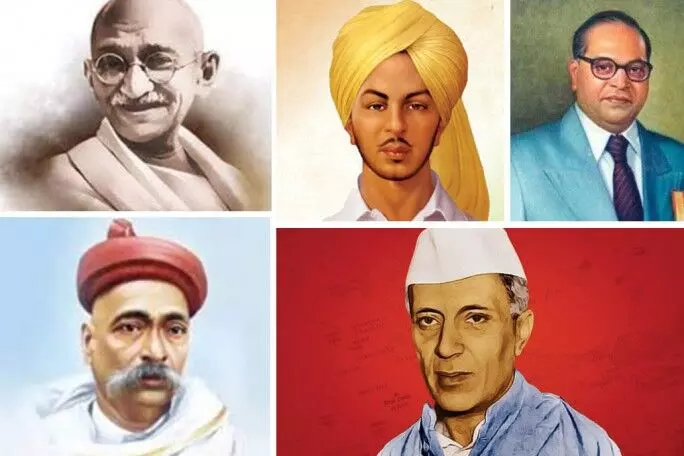Mahatma Gandhi on Indian Currency: The Enduring Legacy and Alternative Suggestions
This article explores the significance of Mahatma Gandhi's portrait on Indian currency, tracing its origins from the colonial era to its establishment as a national symbol in 1969. It delves into the evolution of Indian banknotes, discusses alternative figures proposed for representation, including Rabindranath Tagore and Dr. APJ Abdul Kalam, and examines recent debates surrounding the inclusion of religious deities. The piece also highlights commemorative coins issued by the Government of India, celebrating historical milestones and figures.
image for illustrative purpose

Gandhi on Rupee Notes: The Significance of Bapu’s Portrait and Other Proposed Names
Overview
The evolution of Indian currency from the colonial period to the post-independence era underscores the enduring image of Mahatma Gandhi on banknotes, a tradition that began in 1969. Although there have been suggestions to honor figures like Rabindranath Tagore and Dr. APJ Abdul Kalam, the Reserve Bank of India (RBI) and the Finance Ministry have consistently opted to keep Gandhi’s portrait as a symbol of national identity.
The historical context of Indian currency illustrates a changing array of designs and figures that reflect the sociopolitical atmosphere of their time. Since Mahatma Gandhi's image was first incorporated into Indian banknotes, it has become a lasting symbol, despite occasional demands for alternatives. So, how did Gandhi’s likeness become so prominent in India's currency, and which other notable figures have been suggested for this honor?
The Emergence of Paper Currency in India
The use of paper money in India began in the late 18th century amidst political instability following the decline of the Mughal Empire and the rise of colonial influence. According to the RBI, the introduction of paper currency by British officials in Bengal was a response to a gold and silver shortage caused by the East India Company’s aggressive expansion. The Paper Currency Act of 1861 led to the issuance of India’s first banknotes and coins, which featured Queen Victoria. This initiated a series of banknotes over the following decades, including a 1923 series featuring George V and the introduction of King George VI’s image in 1936.
Post-Independence Currency: Crafting a Unique Identity
After gaining independence on August 15, 1947, India briefly retained the colonial currency system. It wasn’t until August 15, 1950, that the Republic of India introduced its own currency, showcasing the Ashoka Pillar on the notes.
Mahatma Gandhi, a pivotal figure in the independence movement, first appeared on Indian banknotes in 1969, coinciding with the centenary of his birth. His image has since become synonymous with Indian currency, representing the nation's values of peace, unity, and sacrifice.
Alternative Figures Suggested for Indian Currency
While Gandhi’s image is widely accepted, there have been periodic calls to feature other prominent personalities. Notable among these were Rabindranath Tagore, the Nobel Prize-winning poet, and Dr. APJ Abdul Kalam, the former President and renowned scientist. There were also contentious suggestions to include religious figures like Lord Ganesha and Goddess Lakshmi on currency notes, symbolizing prosperity and divine favor. However, the RBI, supported by the Finance Ministry, has consistently maintained Gandhi’s position on Indian currency, viewing his image as a reflection of the country’s spirit. In 2016, Minister of State for Finance Arjun Ram Meghwal mentioned that a committee formed during the UPA government had already decided to uphold Gandhi’s image. Finance Minister Arun Jaitley emphasized that any alterations to currency designs are conducted in collaboration with the RBI.
The AAP Debate in 2022
In 2022, the discussion regarding figures on Indian currency gained new momentum when the Aam Aadmi Party (AAP) proposed the inclusion of Goddess Lakshmi and Lord Ganesha to symbolize national prosperity. This suggestion sparked significant political controversy, with opposition leaders and members of the ruling Bharatiya Janata Party (BJP) opposing the idea.
Commemorative Coins: Celebrating Legacy
While Gandhi's likeness remains predominant on Indian banknotes, the Government of India has also issued a variety of commemorative coins over the years, celebrating significant milestones, historical figures, and events. In 2010 and 2011, coins valued at Rs 75, Rs 150, and Rs 1000 were minted to honor the RBI's Platinum Jubilee, the 150th birth anniversary of Rabindranath Tagore, and a thousand years of the Brihadeeswarar Temple, respectively. Additionally, special edition coins, such as the Rs 125 coin commemorating the birth anniversaries of Sarvepalli Radhakrishnan and B.R. Ambedkar, have been released.

